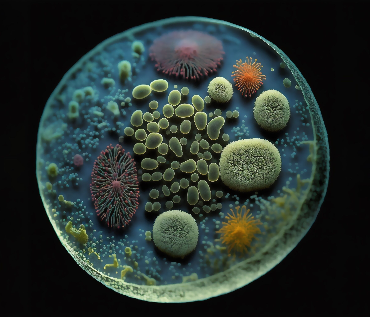Table of content
2. Significance of Particle size analysis
3. Which Industries Rely on Particle Analysis?
4. How does Particle Size Analysis Play a Crucial Role in Pharmaceutical Quality Control?
5. Which New Techniques Have Emerged for Particle Analysis?
Introduction
Information on the size distribution of particles is provided through particle size analysis. This may be used to determine a particle's many attributes and how they will behave in certain scenarios. For many sectors to succeed, this information is essential. Materials research, medicines, environmental monitoring, and industrial processes all employ particle size analysis as a critical tool. It entails figuring out the particle size distribution of a sample, which reveals important details on the physical and chemical characteristics of the particles.
Particle size analysis is significant for the following reasons:
1. Quality assurance:
For many goods, particle size is an important metric. The efficacy, stability, look, and texture of a product can be impacted by the size of the particles in sectors including medicines and cosmetics. Manufacturers can guarantee consistent product quality and adhere to regulations by analysing particle size.
2. Product Performance:
The performance of various materials and products is influenced by particle size. The usefulness and effectiveness of active substances, additives, or pigments are directly influenced by their particle size in sectors including medicines, cosmetics, paints, and coatings. For a product to work as planned and to have consistent quality, understanding and managing particle size is essential.
3. Formulation Development:
To create goods with the best qualities, particle size measurement is crucial. Properties including stability, viscosity, flowability, dissolving rate, and bioavailability are all impacted by the size distribution of the particles. Researchers and formulators can improve formulations by analysing particle size, ensuring that goods match specified specifications and performance criteria.
4. Material Characterization:
Particle size analysis offers insightful information about the behavior and physical characteristics of materials. Understanding variables like surface area, porosity, packing density, and mechanical characteristics is aided by this. The selection of materials, the design of processes, and the prediction of material performance in diverse applications all depend on this knowledge.
5. Safety and health considerations:
Analyzing the size of the particles in a substance is crucial for determining any possible threats to one's health or safety. For instance, risks associated with inhalation or skin penetration may exist with fine particles or nanoparticles. Researchers and authorities may assess possible dangers, set exposure limits, and create suitable safety measures by analyzing particle size distribution.
6. Environmental Impact:
Particle size measurement is important for monitoring the environment and determining how particulate matter affects air, water, and soil quality. Understanding the origin, movement, and behavior of particles, including pollutants and toxins, is aided by this. Researchers can assess environmental dangers, create mitigation plans, and judge the success of clean-up operations by looking at particle size.
Particle size analysis, as a whole, offers insightful information on the physical and chemical characteristics of particles, allowing for improved process optimization, environmental monitoring, and product design. It is a flexible tool that aids businesses and researchers in making wise choices, enhancing the performance of their products, and guaranteeing regulatory compliance.
Which Industries Rely on Particle Analysis?
Many different sectors, especially those that rely on quality control, depend on particle size analysis. To assess the quality and safety of the finished product, almost every business that mills or grinds items uses particle size analysis. Particle size analysis is a method for describing the distribution of particles in a sample. Any sample type (solid, liquid, or gas) can be analyzed using this technique. The process for particle size analysis may fluctuate slightly depending on the industry, and several methods may be used to assess particle size. While some of these techniques may be used with a variety of samples, others were created with a particular kind of sample in mind.
Particle size analysis has been employed as a tool of quality control in a variety of industries, including pharmaceuticals, construction materials, paints and coatings, food and drink, and aerosols. Following are a few examples of industries in which particle size analysis plays an important role.
I. Analysis of Particle Size in the Pharmaceutical Sector
Since particle size affects the surface area and porosity, measuring particle size is essential to guaranteeing product bioavailability, effectiveness, and shelf life. Analysis of particle size is one of the key factors to consider while creating new pharmaceutical medications. Many technology companies like ImageProVision offer numerous solution-based products for particle size analysis.
- Metabolic rate and size
The pace at which a material dissolves can be influenced by particle size. Because the surface area of tiny particles is less, disintegration happens more quickly. This knowledge is used by the pharmaceutical industry to create medications with smaller surfaces that will be metabolised more quickly. Water-soluble drugs will likewise dissolve more quickly if their particles are smaller.
- Drug manufacturing
The respiratory system, which regulates the body's air supply and prevents any possible lung injury, filters out particles larger than a specific size. Particle size must be taken into account when developing medications for oral or nasal administration for them to reach the lungs. Additionally, dust and mist can be harmful to breathe, therefore care must be given when dealing with these.
- Drug delivery
A laser beam is used in nanoparticle tracking analysis (NTA) to scan a container containing suspended particles. The laser is scattered by the particles, which makes it possible to see and examine them. Since the particle size of medications may alter diffusion rates, immunological responses, and drug uptake/delivery, NTA can be utilized to build tailored drug delivery systems.
II. Particle Size Analysis in Construction Materials
Construction projects involving carpentry, insulation, plumbing, roofing, and structural reinforcement all call for the use of building materials. The particle size and form of the raw material used to create the final building materials are crucial in defining these parameters since each of these regions calls for building materials with certain qualities. To guarantee that the materials produced are secure and appropriate for their intended use, particle size analysis is a crucial phase in the manufacturing process.
- Analysis of Particle Size in Paints and Coatings
Particle size affects the general characteristics of pigment dispersions used in paint and coatings. Particle size also affects the optical characteristics of a paint or coating, such as those that determine the product's finish, including its opacity, tinting strength, undertone, gloss/film appearance, and weather resistance.
- Measurement of Particle Size in the Food and Drinks Sector
Many culinary products, including coffee, chocolate, mayonnaise, milk, sugar, and wheat, employ particle size analysis for quality control and product development. Particle size has a significant impact on the stability and preservation of food. Food items in powder form, like flour, are susceptible to caking, and emulsions, like milk, may experience stability problems due to uneven particle size distribution.
Particle size has an effect on beverages with emulsions as well. By changing this component, their flavor and color may be managed. Particle size may be used to characterize liquids like cream liqueur and flavor emulsions, and it can be optimized to determine the shelf life of the product and the likelihood that it will form sugar crystals, which can affect the product's quality.
- Analysis of Particle Size in Aerosols
Analyzing particle sizes is essential when creating aerosols. The production of medicinal inhalers serves as the greatest illustration of this. Particle size analysis is done to confirm that the product is safe for clinical use to assure the safety and efficacy of these products, which are based on the dispersion of the aerosol particles.
How does Particle Size Analysis Play a Crucial Role in Pharmaceutical Quality Control?
Due to its invaluable information on the physical properties of medicinal ingredients and products, particle size measurement is vital to pharmaceutical quality control. Particle size analysis is crucial for pharmaceutical quality control for the following reasons:
- Drug Performance and Bioavailability:
Particle size has an immediate impact on the efficacy and bioavailability of drugs. Drug solubility, absorption in the body, and rate of dissolution are all influenced by particle size. Pharmaceutical firms can modify medication formulations to guarantee consistent and desirable drug release patterns, increase drug stability, and boost treatment efficacy by analyzing particle size.
- Content consistency:
Particle size analysis contributes to the maintenance of pharmaceutical goods' content consistency. Inconsistent particle size distribution might result in changes to the medication content of a dosage form. Manufacturers may guarantee that each dose includes the proper quantity of active pharmaceutical ingredient (API) by monitoring and adjusting particle size distribution, which enhances the quality and effectiveness of the final product.
- Product Stability:
The physical and chemical stability of pharmaceutical goods can be affected by particle size. Agglomeration, moisture absorption, and chemical deterioration are all more likely to occur with fine particles. Manufacturers may evaluate product stability, spot possible degradation or agglomeration problems, and take the necessary action to preserve product quality and shelf life by tracking particle size over time.
- Formulation Optimisation:
Particle size analysis helps to make medicine formulations more effective. Manufacturers can modify formulations to obtain desired particle size characteristics by understanding the link between particle size and other formulation factors, such as excipient choices, blending methods, or processing conditions. Consistent product performance, repeatability, and manufacturability are all guaranteed by this optimisation.
- Inhalation and Aerosolized goods:
For inhalation and aerosolized goods, such as inhalers or nasal sprays, particle size analysis is very important. These formulations' effectiveness and deposition in the respiratory system are influenced by their particle size. By ensuring that the particles are within the appropriate range for effective delivery to the target site, particle size analysis aids in optimizing medicine administration and the patient experience.
- Quality and Safety:
To ensure the quality and safety of a product, particle size analysis is essential. Large particles or aggregates may cause issues including poor flow characteristics, equipment fouling, irregular dosage, or decreased bioavailability. Particle size analysis allows producers to find and remove overly large or undersized particles, guaranteeing that the product satisfies quality requirements and doesn't endanger patient safety.
- Regulatory Compliance:
In the pharmaceutical business, particle size analysis is frequently mandated by regulations. The United States Pharmacopoeia (USP) and the European Pharmacopoeia (EP) both have particular criteria and recommendations for particle size analysis. To prove that pharmaceutical goods are high-quality, reliable, and safe, compliance with these requirements is required.
In conclusion, particle size analysis is essential for pharmaceutical quality control to improve medicine formulations, guarantee consistency in the content, increase product stability, and adhere to legal criteria. Pharmaceutical businesses can maintain product quality, performance, and safety by precisely measuring particle size characteristics, which ultimately benefits patients by supplying effective and dependable treatments. ipvPClass by ImageProVision is an advanced particle size analyzer that renders analysis with speed, convenience, and accuracy.
Which New Techniques Have Emerged for Particle Analysis?
For particle size analysis, several fresh methods have evolved in recent years that provide more precision, effectiveness, and capability.
Here are some noteworthy methods for particle size analysis:
- Dynamic Light Scattering (DLS):
DLS, which is sometimes referred to as photon correlation spectroscopy, tracks changes in scattered light brought on by the Brownian motion of particles in a liquid media. Measurements of the size distribution of colloidal particles and nanoparticle sizing are both often done using this technique. When examining particles of a nanometer or smaller, DLS is quite helpful.
- Laser Diffraction:
Laser diffraction is a popular method for determining the angular distribution of light dispersed by particles. By examining the diffraction pattern created when a laser beam interacts with the particles, it may calculate the size of the particles. With a range of particle sizes from submicron to many millimeters, laser diffraction is useful in a variety of sectors.
- Image Analysis:
Using sophisticated image processing methods, image analysis entails taking pictures of particles and examining their sizes and forms. This method makes it possible to characterize individual particles in great detail and can provide details on several particle characteristics, including aspect ratio, circularity, and surface roughness. Image analysis is frequently applied when accurate form characterization is necessary or when there are irregularly shaped particles.
- Electrical Sensing Zone (ESZ):
In ESZ, sometimes called a Coulter counter or impedance particle counting, the electrical resistance changes when particles move through a tiny aperture. The size and number of particles in a liquid medium may be ascertained by ESZ by identifying these variations. It is especially helpful for analyzing particles ranging in size from submicrons to millimeters, and it can work with many different sample types.
- Nanoparticle Tracking Analysis (NTA):
NTA uses video microscopy to monitor the movement of individual particles in suspension. NTA can identify particle size, size distribution, and concentration by examining the Brownian motion of the particles. The real-time visualization of particle behavior offered by NTA, which is particularly suited for studying nanoparticles, gives new insights into their dynamics.
- Atomic Force Microscopy (AFM):
AFM is a high-resolution imaging method that scans the surface of particles using a pointed probe. At nanoscale sizes, it offers three-dimensional data regarding particle morphology, including size, shape, and surface roughness. Characterizing nanoparticles and surfaces with intricate topographies benefits notably from AFM.
- Resonance Mass Measurement (RMM):
RMM gauges the shift in a cantilever's resonance frequency brought on by particles deposited on its surface. RMM can calculate the particles' mass by examining the resonance frequency shift. Because of its excellent sensitivity, it can analyze extremely minute particles or low concentrations.
- Real-time Image Analysis (Automated Microscopy):
Real-time image analysis has emerged as a groundbreaking particle analysis technique, revolutionizing various industries and research fields. With the rapid advancement of computer vision, machine learning algorithms, and high-performance hardware, real-time image analysis has become a powerful tool for efficiently and accurately identifying, measuring, and characterizing particles in diverse applications.
These are only a few instances of the cutting-edge approaches utilized in particle size analysis. As technology develops, we may anticipate new developments and the creation of increasingly complex techniques for accurate and effective particle size characterization.
The Way Forward
Technological developments, automation, and data analysis are anticipated to influence the direction of particle size analysis in the future. Particle size analysis will become more precise and effective as image analysis techniques and machine learning algorithms progress.
Techniques that can continuously monitor and analyze particle size distribution during production processes or in dynamic situations will become more and more popular. These real-time insights will improve process management, optimization, and quality control.
Characterization of nanoparticles will be ever more important as nanotechnology develops. To get a thorough particle characterization, it is also expected that the future of particle size analysis will require the combination of several analytical methods.
Portable and miniature particle size analysis tools that may be utilized on the go or right where they're needed are in high demand. These compact devices are likely to offer rapid, on-site analysis, making particle size characterization more accessible in multiple industries.
Particle size analysis will become more accurate, automated, real-time monitored, multidimensional, and integrated with modern technology in the future. These developments will make it possible to characterize particles more quickly, accurately, and thoroughly, boosting a variety of businesses' efforts to innovate and enhance the quality of their products and processes.




